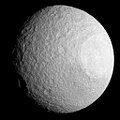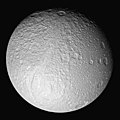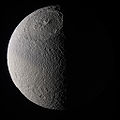Tethys (moon)

Tethys (pronounced TEE-this)[1][2] is a large moon of the planet Saturn.
Discovery
It was discovered by Giovanni Domenico Cassini in 1684.[1][2] It was one of the first Saturnian moons discovered.
Physical characteristics
Mass, density and volume
Tethys' mass is 617,551,805,221,061,000,000 kg, its density is 0.973 g/cm3 and its volume is 634,264,255 km3.[3]
Craters and valleys
It has a very large crater on its surface, called Odysseus.[1] It is named after a Greek warrior king in Homer's two great works, The Iliad and The Odyssey.[1] There is also a very long valley called Ithaca Chasma. It is 100 km wide and 2000 km long.[1][2]
Orbit and rotation
Tethys takes 45.3 hours to orbit (go around) Saturn[2] and orbits Saturn 294,660 km away.[2] Tethys is tidally locked in phase with its parent planet - one side always faces toward Saturn.[1]
Tethys (moon) Media
John Herschel, the astronomer who suggested that the moons of Saturn be named after the Titans and Giants
Size comparison between Tethys(lower left), the Moon (upper left) and Earth
Tethys viewed by Cassini (11 April 2015).
Cassini view of Tethys's Saturn-facing hemisphere, showing the giant rift Ithaca Chasma, crater Telemachus at top, and smooth plains at right
References
- ↑ 1.0 1.1 1.2 1.3 1.4 1.5 Harvey, Samantha (2011-03-04). "NASA: Solar System Exploration: Planets: Saturn: Moons: Tethys". NASA. Archived from the original on 2007-06-09. Retrieved 2011-03-13.
- ↑ 2.0 2.1 2.2 2.3 2.4 Piazza, Enrico. "NASA: Jet Propulsion Laboratory: Cassini Solstice Mission: About Saturn & Its Moons: Saturn's Moons: Tethys". NASA. Archived from the original on 2016-04-04. Retrieved 2011-03-13.
- ↑ Harvey, Samantha (2011-03-04). "NASA: Solar System Exploration: Planets: Saturn: Moons: Tethys: Facts & Figures". NASA. Archived from the original on 2010-05-31. Retrieved 2011-03-13.









